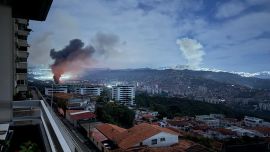When the springs dried up the local indigenous leaders raised their eyes to the heavens. They knew what they would find. Up above, the glacier that capped Chimborazo volcano was receding.
But something equally dramatic was happening further down the slopes of Ecuador's highest mountain. And the consequences for the indigenous population living there are far reaching.
The paramo -- the alpine wetland ecosystem, whose spongy soils hold water flowing from the glacier -- had been taken over by crops and cattle.
Local community leader Gustavo Paca acknowledges it was an error that would shorten its life and hurt his people, who have long seen themselves as nature's guardians.
Paca, 49, protected from the biting cold by a huge red wool poncho and a black hat, put it down to his people's "ignorance".
Now it is they themselves that have caused serious damage to the ecosystem at the base of the 6,310-meter volcano.
For years, no one living in the shadow of Mount Chimborazo imagined the glacier that supplies the paramo could ever be diminished.
Scientists believe the use of fossil fuels such as coal has accelerated the melting process.
But the diminishing glacier would not have affected the ecosystem so much if the wetlands had not been altered at the base of the mountain.
But locals began to cultivate the paramo and introduced cattle that destroyed the soil. In other parts of the paramo, they planted pasture to feed the animals.
- Shrinking glacier -
"Because in the lower part nothing was growing, we said to ourselves: let's move upwards because there the land is fertile," said Paca.
"We produced a great deal, but today, we can see that the Waterflow has decreased."
In warm weather, the glaciers melting waters feed the paramo wetlands below. But with the glacier receding, there is less water supplying the wetlands.
Local populations are feeling the change.
"They depend on glacial water for their crops, their animals, their consumption," says Bolivar Caceres, an expert from Ecuador's Institute of Meteorology and Hydrology (INAMHI).
Over the last 58 years, Chimborazo's imposing mane of snow has receded to its peak, while its slopes have become a patchwork of crops.
Maria Chaza, 70, remembers the snow and the paramo with its vegetation of grasses and aromatic shrubs, now cleared for farmland.
"What a wonderful mountain it was, now there are only fields, cattle, Chimborazo has been skinned, and because of that there is no water," she said. "Because of that we suffer."
- Water flowing away -
Their wells drying up, men from local indigenous communities are now having to forage for water, hoes in hand, ready to dig in the loamy soil for new water sources. It's work that increasingly demands more effort.
Scientists first began recording a retreat in the Chimborazo glacier in 1962. They measured the glacier at 27 square kilometers (10.4 square miles). By 2016, it had shrunk to only 7.6 square kilometers
"It had lost 72 percent of its cover," says Caceres.
It's nearest neighbor, the 5,020 meter Carihuairazo volcano is in an even more critical state, losing 96 percent of its glacier since 2003. Today it's no bigger than a football stadium.
Five other Ecuadoran peaks have been affected.
"The water courses are drying up," according to Francisco Hidalgo, head of the local government in San Andres.
While the indigenous communities once had springs about five kilometers (3 miles) from their village, they now have to travel up to three times that distance to draw water from natural wells, more than 4,000 meters above sea level.
- Sterile lands -
Some communities have been able to regenerate the paramo by planting native vegetation and replacing cattle with llamas and vicunas, native Andes species whose padded feet are kinder to the soil.
Many now have to pay for a resource they previously accessed from nature.
"We are buying paramos" to plant locally, to retain the water on the land, said America Guilcapi, leader of the Pulingui indigenous community on the mountain's slopes.
There is no quick fix. They are currently managing to irrigate only 17 of their community's 105 arable hectares.
But slowly, local communities have started to implement a wider plan to retain their water supplies.
That consists in buying hundreds of hectares of virgin land to increase their water catchment.
"There are communities that are devastated, with useless land, which is why we are working to improve irrigation systems," said Hidalgo.
-TIMES/AFP
by Paola López


























Comments